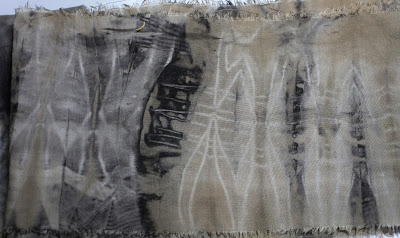I have a lot of 'masters' here; plans, frameworks, ideas, thoughts that determine each step. Plots, I suppose. One is the kasaya or kesa or okesa, a ritual garment worn by Buddhists. In its ideal form (which is sometimes also it's literal form) it is a whole cloth made of collected, washed and assembled rags. It is also commonly assembled of sumptuous cloth, brocaded silks, damask. Sometimes sedately coloured cotton or linen. As long as it is built in a patchwork, following a fixed pattern, it can become a proper garment. So I collected a bundle of the smallest scraps of found cloth.
The basic idea of composing something from rags of course appeals to me. The idea of a pattern to fit these into adds something I need for this. The plot, a kind of pattern, drives the composition. The pattern I settled on, below, is to build nine sections, three by three. The process then is to fill three large panels diagonally from top left to bottom right, where the centre panel is the bird, her nest and a bee; the corners on the left bottom and right top are made up of small patches. The panels on either side of and above and below the centre panel are bars.
I wanted the little story of the bird, her nest, the compassion of her helpers, at the centre, because it is a singularly important moment. But I also wanted this piece to fit within, to be as much a part as each other part. The logic of the kesa, of a fixed plot which brings singular parts together, helps me. This singular story belongs within a story of building a life and understanding in relation. In interactions, experience. Within context. And from there, once I had started working on this cross shape, I started to fill in the other fields. Some of them with little, tiny bits of cloth.
And just as soon as I was filling up these sections, maintaining their boundaries, I didn't like it. So I started to let these filled in spots start to leak, extend beyond those boundaries. Here these impossibly small printed leaves flicker out of a piece of blue cotton into a white section.
I'm responding to the shapes of the tiniest scraps.
I'm responding to things that are already falling apart, but also coming together. So now I've collected these little scraps of abrasion and wear.
These are things that show interactions, with wind, rain, sunshine. With insects and roots.
With objects the cloth was lost with, or that was on the ground where it was discarded.
Below is the bottom of the lining of a pair of pants, where stitches in the hem left wear, and where the back of the cuff dragged on the ground.
This is from the same piece, at the knee. So maybe this is a record of a skinned knee.











.jpg)

.jpg)
.jpg)
.jpg)

.jpg)